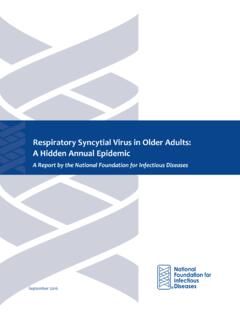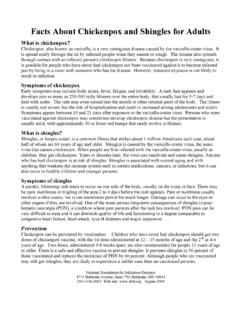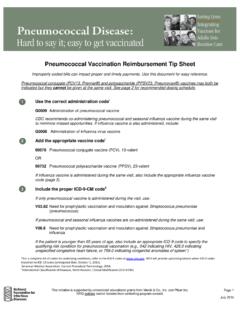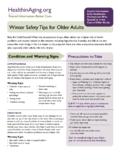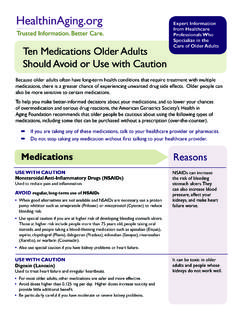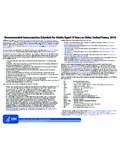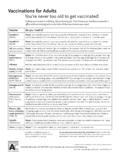Transcription of Respiratory Syncytial Virus in Older Adults: A …
1 September 2016 Respiratory Syncytial Virus in Older adults : A Hidden Annual EpidemicA Report by the National Foundation for Infectious DiseasesOverviewRespiratory Syncytial Virus (RSV) is a common cause of acute Respiratory illness in Older adults , with the risk of serious infection increasing with 4 The Virus circulates along with many other winter Respiratory viruses, most notably seasonal influenza, and is largely indistinguishable from influenza based on clinical presentation ,5,6 RSV is second only to influenza as a cause of medically significant Respiratory tract illnesses in adults7,8 and is estimated to cause 177,000 hospitalizations and 14,000 annual deaths in US adults age 65 years and ,9 There is no specific treatment for RSV in adults and currently no licensed vaccine to prevent the disease. However, several promising candidate vaccines are on the horizon to protect populations at increased risk of serious RSV outcomes, including Older RSV epidemiology and burden of disease suggest vaccines should target infants younger than age six months, infants and children age six to 24 months, pregnant women (to provide passive immunity to newborns), and adults age 65 years and The focus of this report is on the Older adult and defining the impact of RSV in Older adults is important in order to evaluate the impact of new prevention and treatment options that will likely be available in the US soon.
2 Public health and healthcare professionals (HCPs) need to educate themselves about RSV so they can advise the general public and Older patients about the importance of prevention. Respiratory Syncytial Virus in Older adults : A Hidden Annual Epidemic Recognizing and defining the impact of RSV in Older adults is important in order to evaluate the impact of new prevention and treatment options that will likely be available in the US soon. William Schaffner, MD1 RSV: A Pervasive Infection with Lifelong ReinfectionsRSV is an RNA Virus that was isolated in the mid-1950s from a captive chimpanzee with upper Respiratory tract It is classified in the Paramyxoviridae family, which includes parainfluenza, meta-pneumovirus, and measles viruses. Humans are the only known subtypes A and B co-circulate. Some data indicate that RSV subtype A may cause more severe disease. Two surface glycoproteins, F and G, are responsible for initiation and propagation of RSV infection in the host.
3 The G protein differs on the RSV A and B subtypes, but the F protein is antigenically stable with minimal difference between subtypes (Figure 1).7,13 RSV epidemics occur annually during the winter months in temperate regions, with most US infections occurring in a 22-week period from November to By age two years, almost all children have been infected with RSV and about half have been infected Immunity is fleeting and reinfection is common throughout the lifespan. Hall and colleagues16 challenged 15 healthy young adults with RSV at two, four, eight, 14, 20, and 26 months following natural infection. The rate of reinfection was highest after the first challenge (~50 percent) showing that just two months after RSV infection, otherwise healthy adults were already susceptible to reinfection. The cumulative reinfection rate was two-thirds by eight months and over the course of the approximately two-year study, 73 percent had two or more and 47 percent had three or more pathogenesis of disease associated with RSV is well described in young children, but little is known about the pathogenesis in Older adults .
4 In children, RSV usually begins as an infection in the nasal mucosal epithelial The RSV virion attaches to and penetrates ciliated nasal epithelial cells by fusing with the cell membrane, entering, and replicating in the cytoplasm. Infectious Virus buds from and exits the infected cells via apical membrane on the lumenal side (the same side of entry) of the airway, and is not released into the systemic circulation through the basement membrane. This restricted replication may be why RSV is not a systemic Virus , making it difficult for the immune system to mount a very strong and durable systemic 1: Respiratory Syncytial Virus StructureReprinted from Current Opinion in Immunology, Volume 35, Graham BS, Modjarrad K, McLellan JS. Novel antigens for RSV vaccines, pp 30-38, 2015, with permission from replication results in epithelial-cell sloughing, inflammatory cell infiltration, edema, increased mucous secretion, and impaired ciliary action.
5 The sloughed cells create an obstruction; during inhalation the airway opens, but on exhalation when the lungs deflate, the airway can become obstructed, causing air trapping and Disease: Age-Related SeverityRSV is associated with the most severe disease at the extremes of ,6,18,19 In infants, RSV causes bronchiolitis, pneumonia, tracheobronchitis, and otitis media, while in Older adults it can cause pneumonia, as well as exacerbation of chronic obstructive pulmonary disease (COPD) and congestive heart failure (CHF). For healthy Older children and young adults , clinical presentation of RSV resembles the common cold, with mild to moderate cough and nasal RSV presents similar to the common cold it is unlikely to cause significant fever, giving patients no signal to self-isolate. If they go to work in day cares, nursing homes, hospitals, and other locations, they may unknowingly spread RSV to others who may be more vulnerable to severe Factors for More Severe RSV Outcomes with AgingGradual deterioration of the immune system due to aging (immunosenescence) is one of several reasons why Older adults are at increased risk from viral Respiratory Even the most vital and active Older adult will experience some immunosenescence as a consequence of aging, but it is important to note that age alone is not the only determining factor.
6 Frailty, marked by a lack of physiologic reserve,21 may predict immunosenescence and response to immunization better than ,23As adults age, cellular immunity changes include decreased na ve T cells, increased memory T-cell count, decreased T-cell proliferation with Th1 and Th2 imbalances, and increased levels of inflammatory mediators. Older adults also have decreased B-cell responses to new antigens and decreased cytotoxic T-cell activity, resulting in less effective natural killer cells in the immune , Older adults have decreased strength of the Respiratory muscles and diaphragm, which impedes lung expansion. Older adults also have decreased protective mucus levels, lung compliance, and elastin. Annual Attack Rate and RSV Mortality in adults Age 65 Years and OlderBased on data from a four-year study, the Centers for Disease Control and Prevention (CDC) estimates 14,000 annual deaths caused by RSV in US adults age 65 years and A statistical model by Thompson et al,1 encompassing a 10-year period estimated more than 11,000 annual Respiratory and circulatory deaths due to RSV in the US with 78 percent in patients age 65 years 3and Older .
7 During the surveillance period, RSV was associated with more deaths in this age group than influenza B or the influenza A (H1N1) strain, but fewer deaths than the more severe influenza A (H3N2) a hallmark of influenza is its annual seasonal variability, RSV is more consistent in its attack rate and severity. According to a study by Falsey et al,2 over four winter Respiratory seasons in Rochester, NY (1999-2003), RSV infection developed annually in an average of percent (range, 3 to 7 percent) of healthy adults age 65 years and Older ( , without COPD or CHF) and 4 to 10 percent of high-risk adults age 21 years and Older ( , diagnosed with chronic heart or lung disease). The number of patients with RSV in this study was approximately double the number of patients with influenza, but a high level of influenza vaccination coverage was noted in the study investigators also evaluated all adults age 65 years and Older and those with underlying cardiopulmonary disease at any age who were admitted to a local hospital with a spectrum of acute cardiopulmonary symptoms.
8 RSV and influenza were responsible for percent and percent of these hospitalizations, respectively. Based on discharge diagnosis, RSV accounted for percent of hospitalizations for pneumonia, percent for COPD, percent for asthma, and percent for Cost of RSV in Older AdultsThere are limited data on the cost of RSV in adults . A study published in 2000 estimated the annual cost of RSV-related acute Respiratory infection in adults age 65 years only at almost $103 Based on Social Security Administration estimates of an additional 19 to 21 years life expectancy for individuals reaching age 65 years today,25 a progressively aging population, and rising healthcare costs, the US price tag for RSV in the age 65 years and Older population is likely much greater and may be well into the billions of striking finding in this study was that nearly half of the total cost of RSV was for outpatient oral antibiotics,24 which would only be medically appropriate for patients with bacterial co-infection.
9 The study by Falsey et al,2 found that only 10 percent of Older and high-risk adults hospitalized with RSV infection had concomitant bacterial infection. In addition to adding to unnecessary costs, overuse of antibiotics is the single most important risk factor leading to antibiotic RSV in people age 65 years and Older could reduce both short- and long-term disability and reduce the burden on the US healthcare system, resulting in: fewer acute illnesses and exacerbations of chronic conditions; less contact with healthcare facilities, especially during the winter Respiratory season; fewer unnecessary antibiotic prescriptions; and less financial Presentation, Diagnosis, and Treatment RSV and influenza A present with strikingly similar symptoms in adults , making it nearly impossible, according to Walsh et al,6 to distinguish between the two infections based on clinical presentation ,3,5,6 Nearly all RSV-infected adults (89 percent) exhibit some combination of acute Respiratory symptoms (Table 1).
10 2 Testing for RSV is not performed routinely in outpatient settings because it is not widely available, it is expensive, and there is no clinical application for the results since there are no 4 RSV illness usually starts with nasal congestion and rhinorrhea, which progress over several days. Cough, often with sputum production, is common and can be accompanied by dyspnea and wheezing, a hallmark of RSV infection across all ages. On average, patients with RSV present to a doctor or the emergency department on day five to seven of the is little difference in RSV and influenza symptoms in adults of any age with high-risk conditions ( , chronic heart or lung disease) and otherwise healthy adults age 65 years and Older without high-risk conditions (Tables 1 and 2).2,3 Healthy adults with RSV tend to report less fever and dyspnea, and more wheezing than adults with influenza. Among hospitalized adults with RSV a substantial proportion report wheezing with both RSV (73 percent) and influenza infection (53 percent).
